Impact of Nutritional Management on Available Mineral Nitrogen and Soil Quality Properties in Coffee Agroecosystems
Abstract
1. Introduction
2. Methods
2.1. Study Site
2.2. Experimental Design to Determine Physical and Chemical Soil Properties
2.3. Soil Samples and Laboratory Analysis
2.4. Statistics Analysis of Soil Properties
3. Results
4. Discussion
4.1. Nutritional Management Effects on Available Mineral Nitrogen
4.2. Impact of Nutritional Management in Soil Quality Properties
5. Conclusions
Author Contributions
Funding
Acknowledgments
Conflicts of Interest
References
- BEDRI. En Café en el Mundo. 2006. Available online: http://www.bedri.es/Comer_y_beber/Cafe/El_cafe_en_el_mundo.htm (accessed on 20 January 2019).
- Cardenas, J. Colombia, Centroamérica y el Mercado Mundial del Café; Federación Nacional de Cafeteros: Bogotá, Colombia, 2000. [Google Scholar]
- ICO. Consumo Mundial de Café. 2015. Available online: http://noticias.caracoltv.com/mundo/consumo-mundial-de-cafe-se-duplico-en-los-ultimos-20-anos (accessed on 20 January 2019).
- FAO. Climate-Smart Agriculture Sourcebook; FAO: Rome, Italy, 2013. [Google Scholar]
- FNC. Café de Colombia. 2010. Available online: http://www.cafedecolombia.com/particulares/es/la_tierra_del_cafe/la_gente_del_cafe/ (accessed on 20 January 2019).
- Finagro. Perspectiva del Sector Agropecuario Colombiano; Finagro: Bogotá, Colombia, 2014. [Google Scholar]
- FNC and Cenicafé. Manual del Cafetero Colombiano—Tomo 2; Cenicafé: Chinchiná, Colombia, 2013. [Google Scholar]
- Dominghetti, A.W.; Guelfi, D.R.; Guimarães, R.J.; Caputo, A.L.; Spehar, C.R.; Faquin, V. Nitrogen loss by volatilization of nitrogen fertilizers applied to coffee orchard. Ciência e Agrotecnologia 2016, 40, 173–183. [Google Scholar] [CrossRef]
- Leal, L.; Salamanca, A.; Sadeghian, S. Urea volatilization losses from cofee plantations. Better Crops 2010, 94, 18–20. [Google Scholar]
- Gomiero, T.; Pimentel, D.; Paoletti, M.G. Environmental impact of different agricultural management practices: Conventional vs. Organic agriculture. Crit. Rev. Plant Sci. 2011, 30, 95–124. [Google Scholar] [CrossRef]
- Bengtsson, J.; Ahnström, J.; Weibull, A.C. The effects of organic agriculture on biodiversity and abundance: A meta-analysis. J. Appl. Ecol. 2005, 42, 261–269. [Google Scholar] [CrossRef]
- Poudel, D.D.; Horwath, W.R.; Lanini, W.T.; Temple, S.R.; van Bruggen, A.H.C. Comparison of soil N availability and leaching potential, crop yields and weeds in organic, low-input and conventional farming systems in northern California. Agric. Ecosyst. Environ. 2002, 90, 125–137. [Google Scholar] [CrossRef]
- Pimentel, D.; Hepperly, P.; Hanson, J.; Seidel, R.; Douds, D. Environmental, Energetic and Economic Comparisions of Organic and Conventional Farming Systems. Bioscience 2005, 55, 573–582. [Google Scholar] [CrossRef]
- Evanylo, G.; Sherony, C.; Spargo, J.; Starner, D.; Brosius, M.; Haering, K. Soil and water environmental effects of fertilizer-, manure-, and compost-based fertility practices in an organic vegetable cropping system. Agric. Ecosyst. Environ. 2008, 127, 50–58. [Google Scholar] [CrossRef]
- Venter, Z.S.; Jacobs, K.; Hawkins, H.J. The impact of crop rotation on soil microbial diversity: A meta-analysis. Pedobiologia 2016, 59, 215–223. [Google Scholar] [CrossRef]
- Ghabbour, E.A.; Davies, G.; Misiewicz, T.; Alami, R.A.; Askounis, E.M.; Cuozzo, N.P.; Filice, A.J.; Haskell, J.M.; Moy, A.K.; Roach, A.C.; et al. National Comparison of the Total and Sequestered Organic Matter Contents of Conventional and Organic Farm Soils. Adv. Agron. 2017, 146, 1–35. [Google Scholar]
- Keesstra, S.D.; Bouma, J.; Wallinga, J.; Tittonell, P.; Smith, P.; Cerdà, A.; Montanarella, L.; Quinton, J.N.; Pachepsky, Y.; Van Der Putten, W.H.; et al. The significance of soils and soil science towards realization of the United Nations sustainable development goals. Soil 2016, 2, 111–128. [Google Scholar] [CrossRef]
- Rodrigo-Comino, J.; Keesstra, S.; Cerdà, A. Soil Erosion as an Environmental Concern in Vineyards: The Case Study of Celler del Roure, Eastern Spain, by Means of Rainfall Simulation Experiments. Beverages 2018, 4, 31. [Google Scholar] [CrossRef]
- Tumwebaze, S.B.; Byakagaba, P. Soil organic carbon stocks under coffee agroforestry systems and coffee monoculture in Uganda. Agric. Ecosyst. Environ. 2016, 216, 188–193. [Google Scholar] [CrossRef]
- McKean, S. Manual de Análisis de Suelo y Tejido Vegetal; Centro Internacional de Agricultura Tropical (CIAT): Cali, Colombia, 1993; pp. 1–103. [Google Scholar]
- Staff, S.S. Method 3B6a. Soil Survey Laboratory Methods Manual; USDA-NRCS, GPO: Washington, DC, USA, 2004; Volume 42. [Google Scholar]
- EPA. Method 9045D. Soil and Waste pH; Environmental Monitoring and Support Lab., U.S. Environmental Protection Agency: Cincinnati, OH, USA, 2004.
- Cerisola, C. Fertilidad Química; UNLP: La Plata, Argentina, 2015; pp. 1–44. [Google Scholar]
- Tully, K.L.; Lawrence, D.; Scanlon, T.M. More trees less loss: Nitrogen leaching losses decrease with increasing biomass in coffee agroforests. Agric. Ecosyst. Environ. 2012, 161, 137–144. [Google Scholar] [CrossRef]
- Ryan, M.C.; Graham, G.R.; Rudolph, D.L. Contrasting nitrate adsorption in andisols of two coffee plantations in Costa Rica. J. Environ. Qual. 2001, 30, 1848–1852. [Google Scholar] [CrossRef] [PubMed]
- Tully, K.L.; Wood, S.A.; Lawrence, D. Fertilizer type and species composition affect leachate nutrient concentrations in coffee agroecosystems. Agrofor. Syst. 2013, 87, 1083–1100. [Google Scholar] [CrossRef]
- Lim, S.L.; Wu, T.Y.; Lim, P.N.; Shak, K.P.Y. The use of vermicompost in organic farming: Overview, effects on soil and economics. J. Sci. Food Agric. 2015, 95, 1143–1156. [Google Scholar] [CrossRef]
- Velmourougane, K. Impact of Organic and Conventional Systems of Coffee Farming on Soil Properties and Culturable Microbial Diversity. Scientifica 2016, 2016, 3604026. [Google Scholar] [CrossRef]
- Novara, A.; Pulido, M.; Rodrigo-Comino, J.; Di Prima, S.; Smith, P.; Gristina, L.; Giminez-Morera, A.; Terol, E.; Salesa, D.; Keesstra, S. Long-term organic farming on a citrus plantation results in soil organic carbon recovery. Cuad. Investig. Geogr. 2019, 45, 271–286. [Google Scholar] [CrossRef]
- Ginés, I.; Mariscal, I. Incidencia de los Fertilizantes Sobre el pH del Suelo; UPM: Madrid, Spain, 2002; pp. 1–9. [Google Scholar]
- Zapata, R. Origen de la acídez del suelo. In Química de la Acídez del Suelo; UNAL: Bogotá, Colombia, 2004; p. 30. [Google Scholar]
- McCauley, A.; Jones, C.; Jacobsen, J. Soil pH and Organic Matter. Nutr. Manag. 2009, 8, 12. [Google Scholar]
- Jackson, R.B.; Lajtha, K.; Crow, S.E.; Hugelius, G.; Kramer, M.G.; Piñeiro, G. The Ecology of Soil Carbon: Pools, Vulnerabilities, and Biotic and Abiotic Controls. Annu. Rev. Ecol. Evol. Syst. 2017, 48, 419–445. [Google Scholar] [CrossRef]
- Brar, B.S.; Singh, J.; Singh, G.; Kaur, G. Effects of long term application of inorganic and organic fertilizers on soil organic carbon and physical properties in maize-wheat rotation. Agronomy 2015, 5, 220–238. [Google Scholar] [CrossRef]
- Tian, X.M.; Fan, H.; Zhang, F.H.; Wang, K.Y.; Ippolito, J.A.; Li, J.H.; Jiao, Z.W.; Li, Y.B.; Li, Y.Y.; Su, J.X.; et al. Soil carbon and nitrogen transformations under soybean as influenced by organic farming. Agron. J. 2018, 110, 1883–1892. [Google Scholar] [CrossRef]
- Gangwar, K.S.; Singh, K.K.; Sharma, S.K.; Tomar, O.K. Alternative tillage and crop residue management in wheat after rice in sandy loam soils of Indo-Gangetic plains. Soil Tillage Res. 2006, 88, 242–252. [Google Scholar] [CrossRef]
- Papini, R.; Valboa, G.; Favilli, F.; L’Abate, G. Influence of land use on organic carbon pool and chemical properties of Vertic Cambisols in central and southern Italy. Agric. Ecosyst. Environ. 2011, 140, 68–79. [Google Scholar] [CrossRef]
- Mahmood, F.; Khan, I.; Ashraf, U.; Shahzad, T.; Hussain, S.; Shahid, M.; Abid, M.; Ullah, S. Effects of organic and inorganic manures on maize and their residual impact on soil physico-chemical properties. J. Soil Sci. Plant Nutr. 2017, 17, 22–32. [Google Scholar] [CrossRef]
- Bandyopadhyay, K.K.; Misra, A.K.; Ghosh, P.K.; Hati, K.M. Effect of integrated use of farmyard manure and chemical fertilizers on soil physical properties and productivity of soybean. Soil Tillage Res. 2010, 110, 115–125. [Google Scholar] [CrossRef]
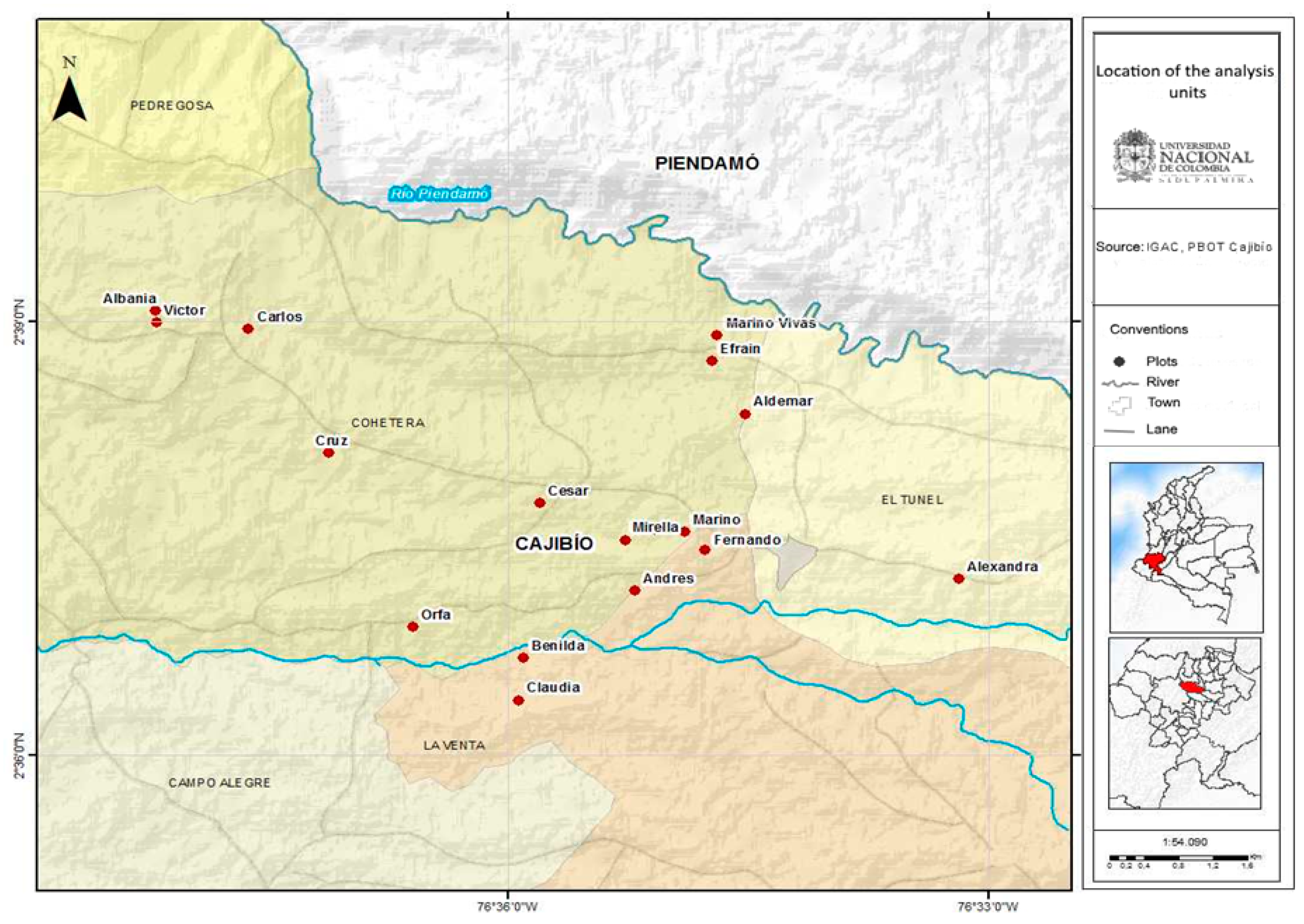
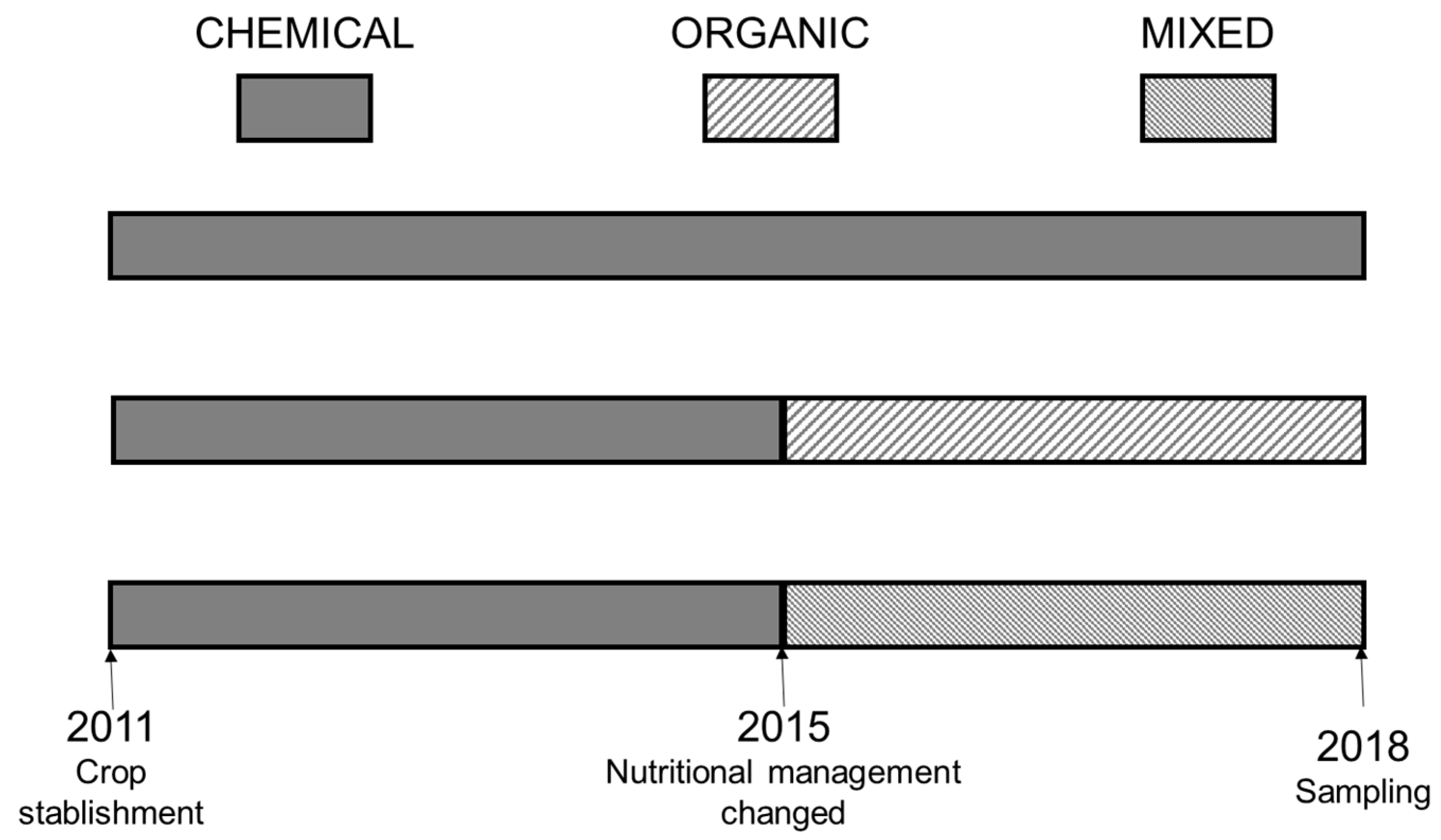
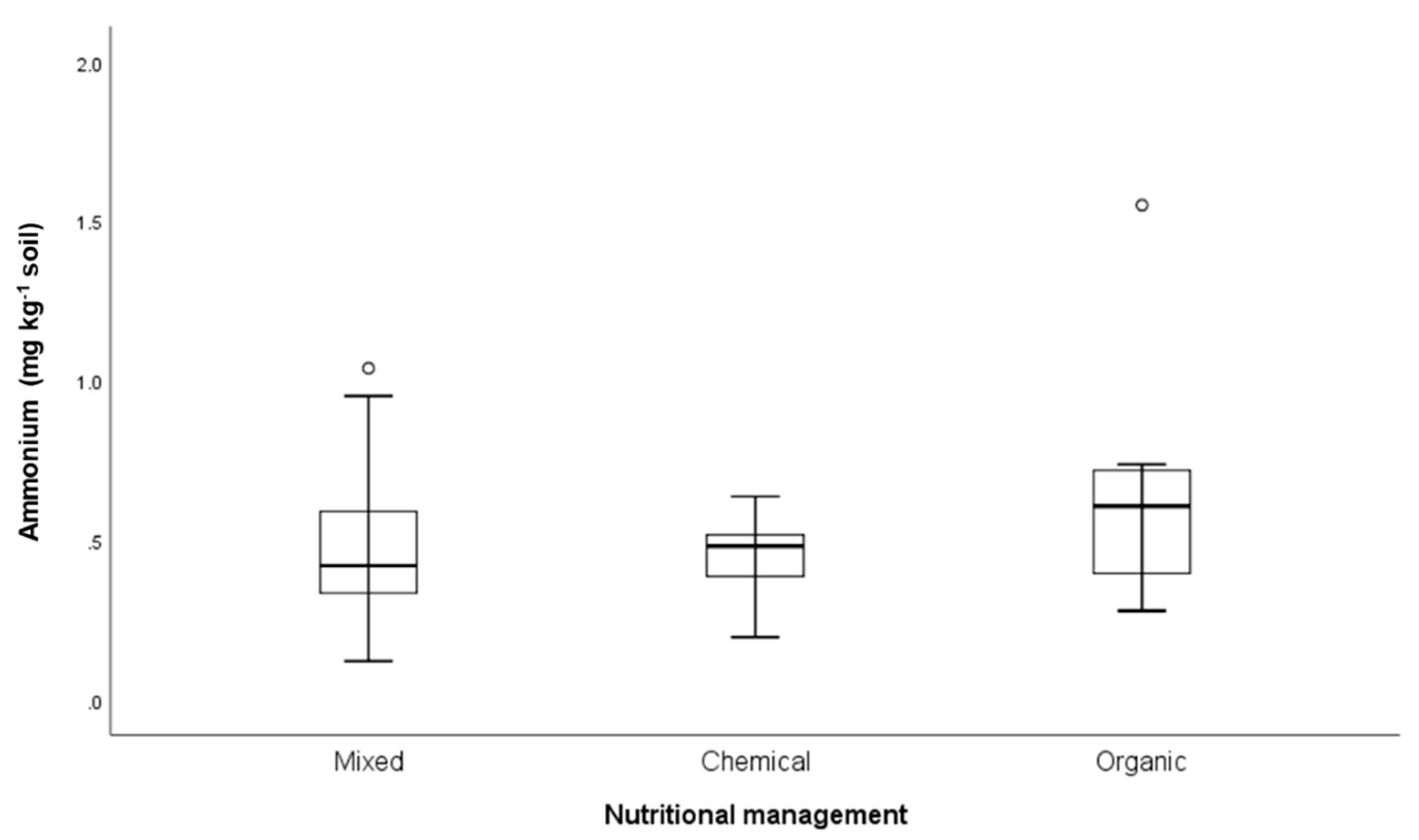
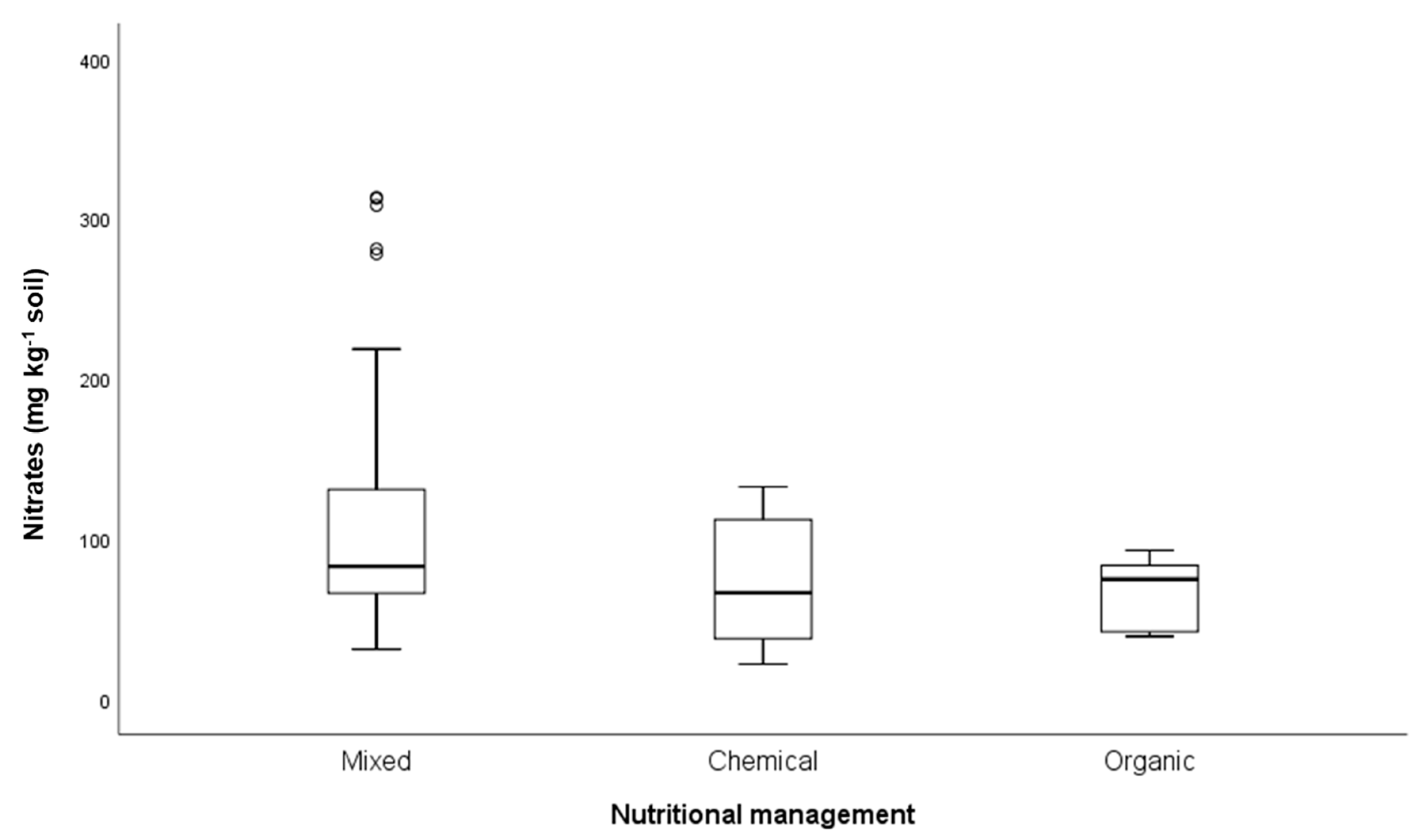
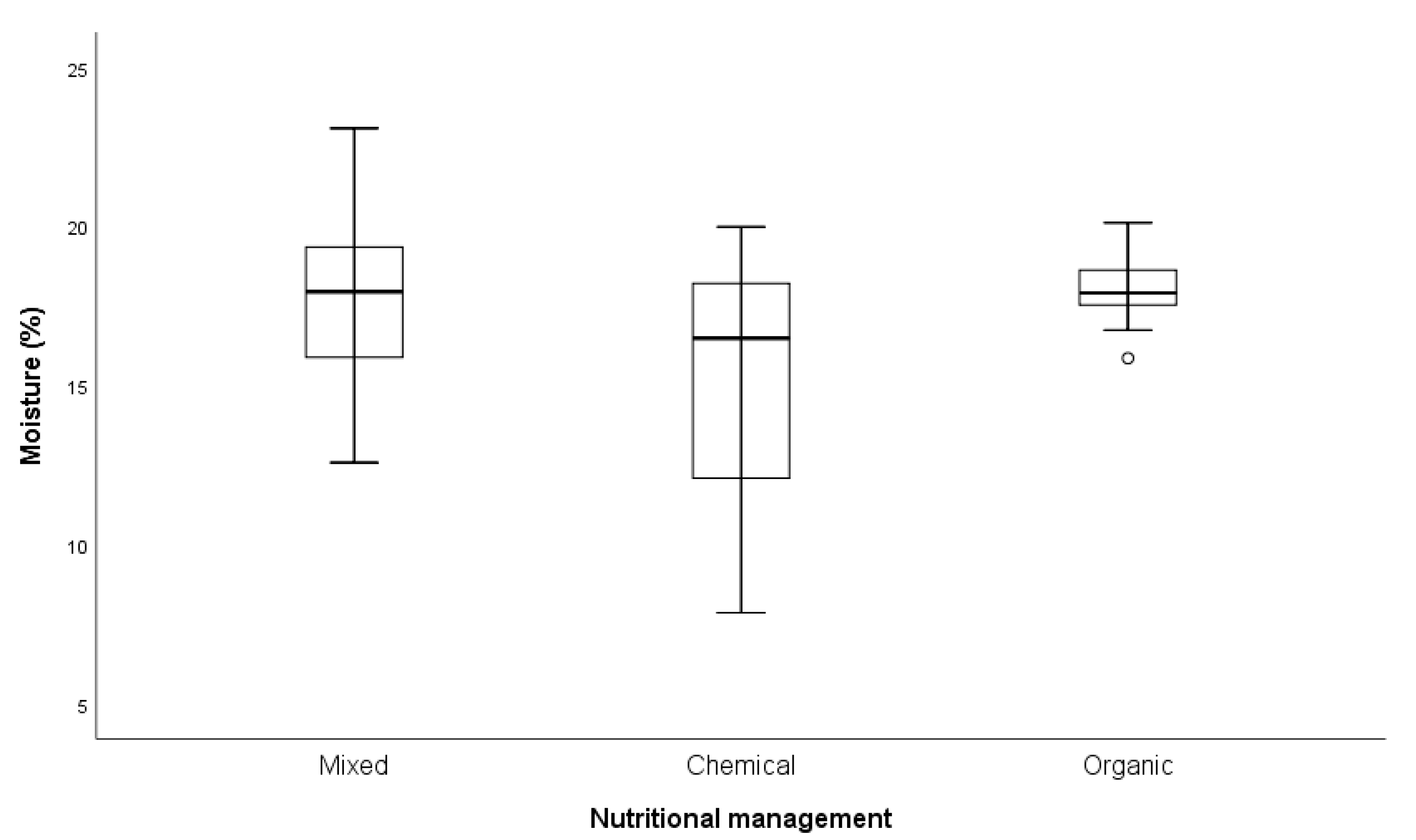
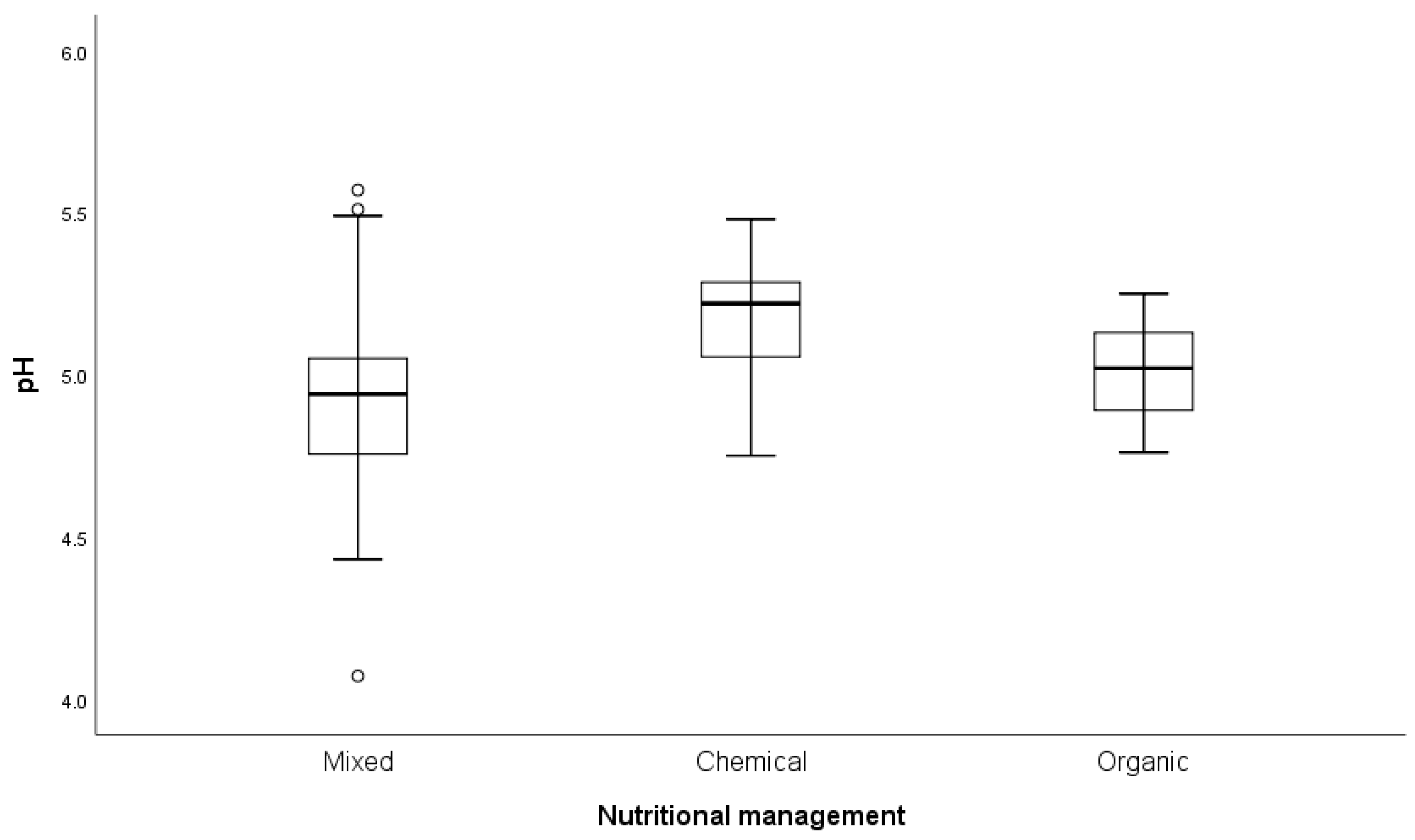
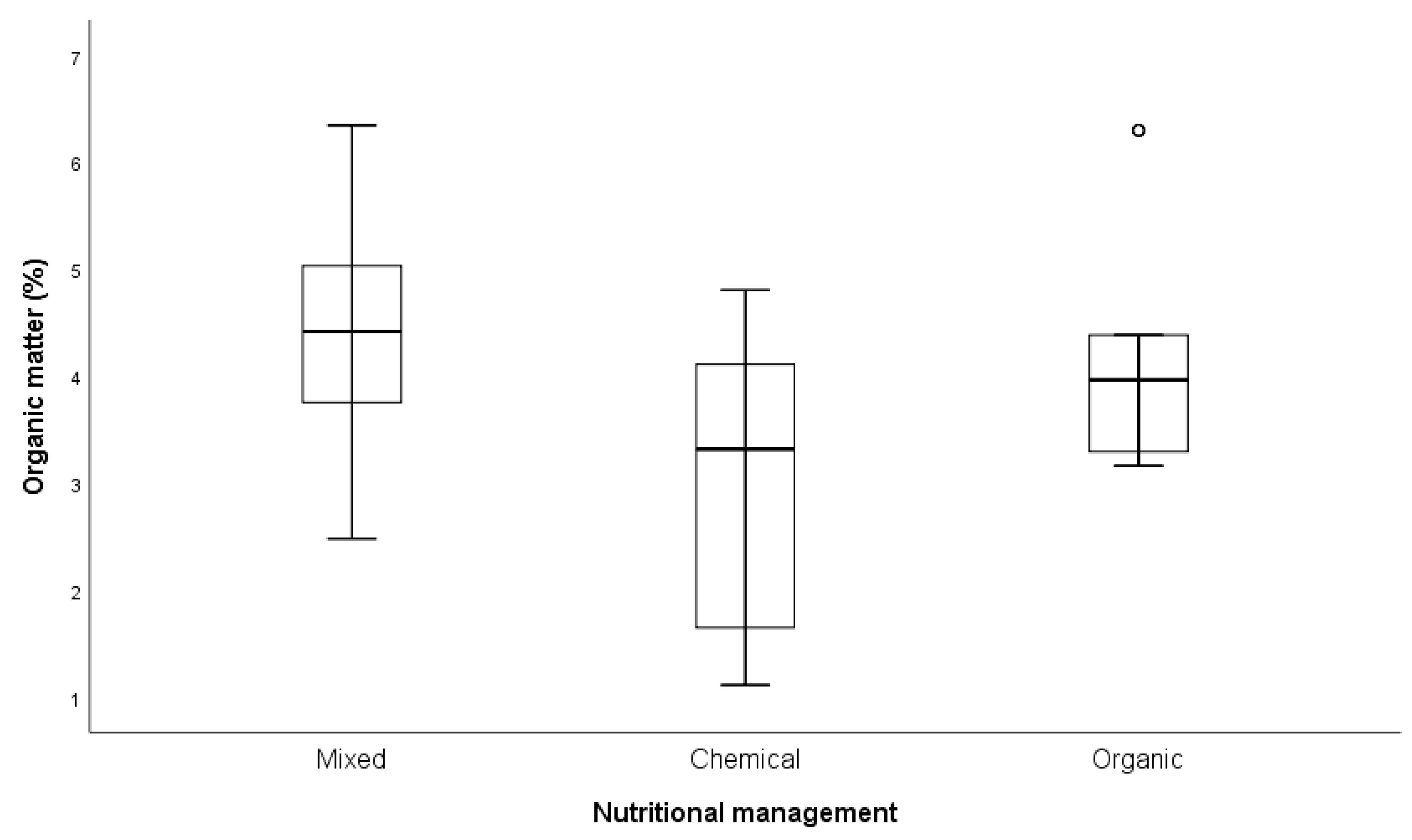
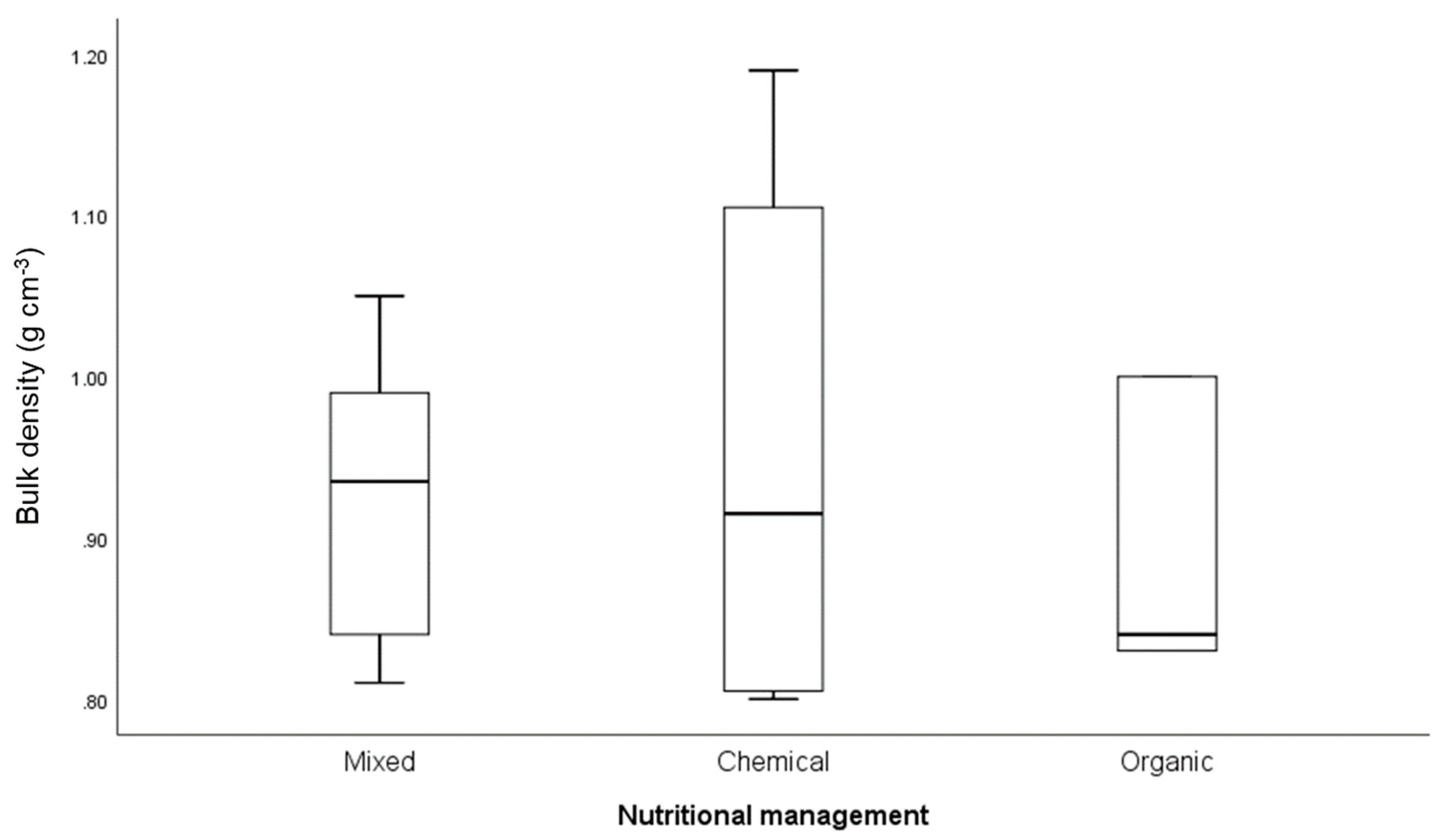

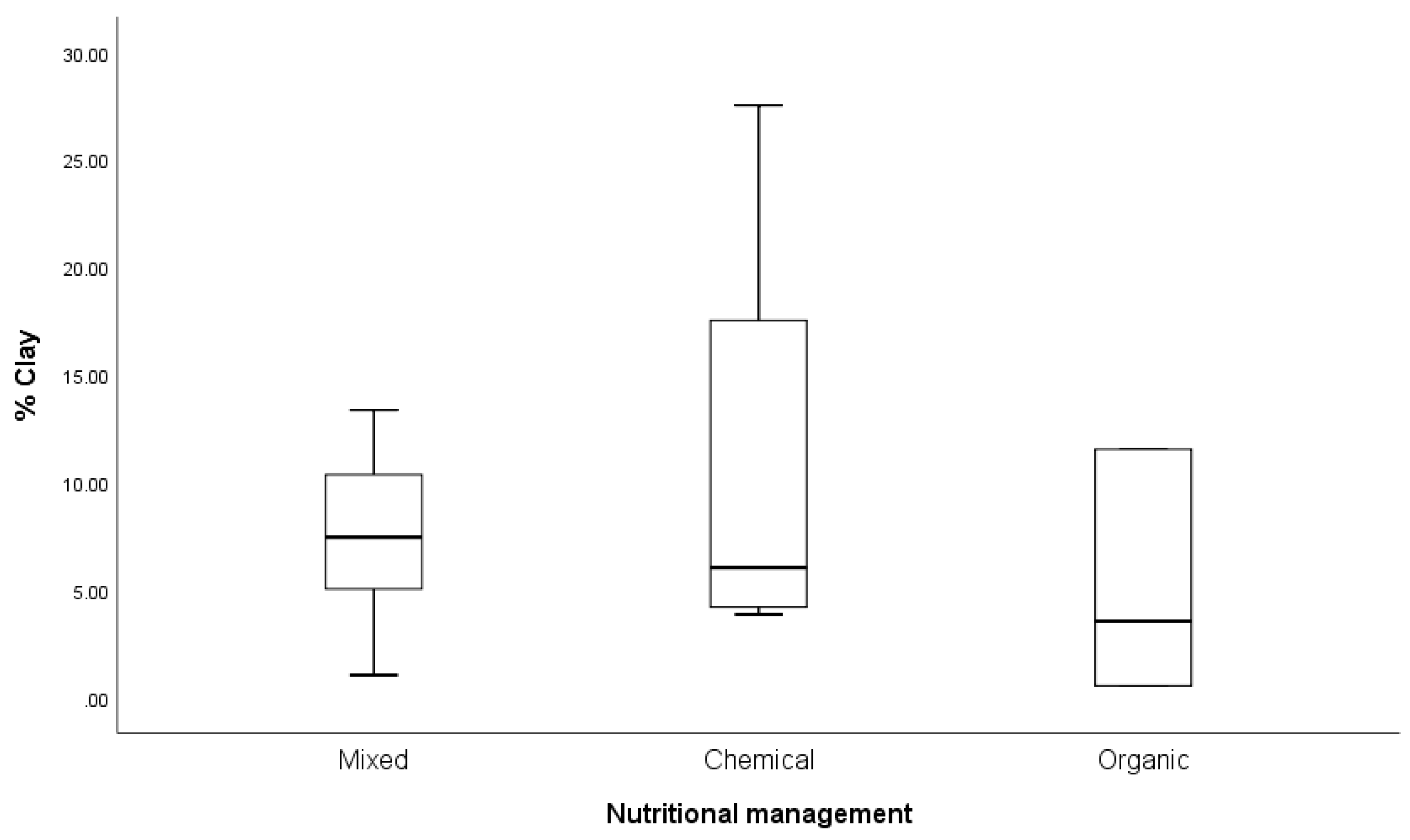
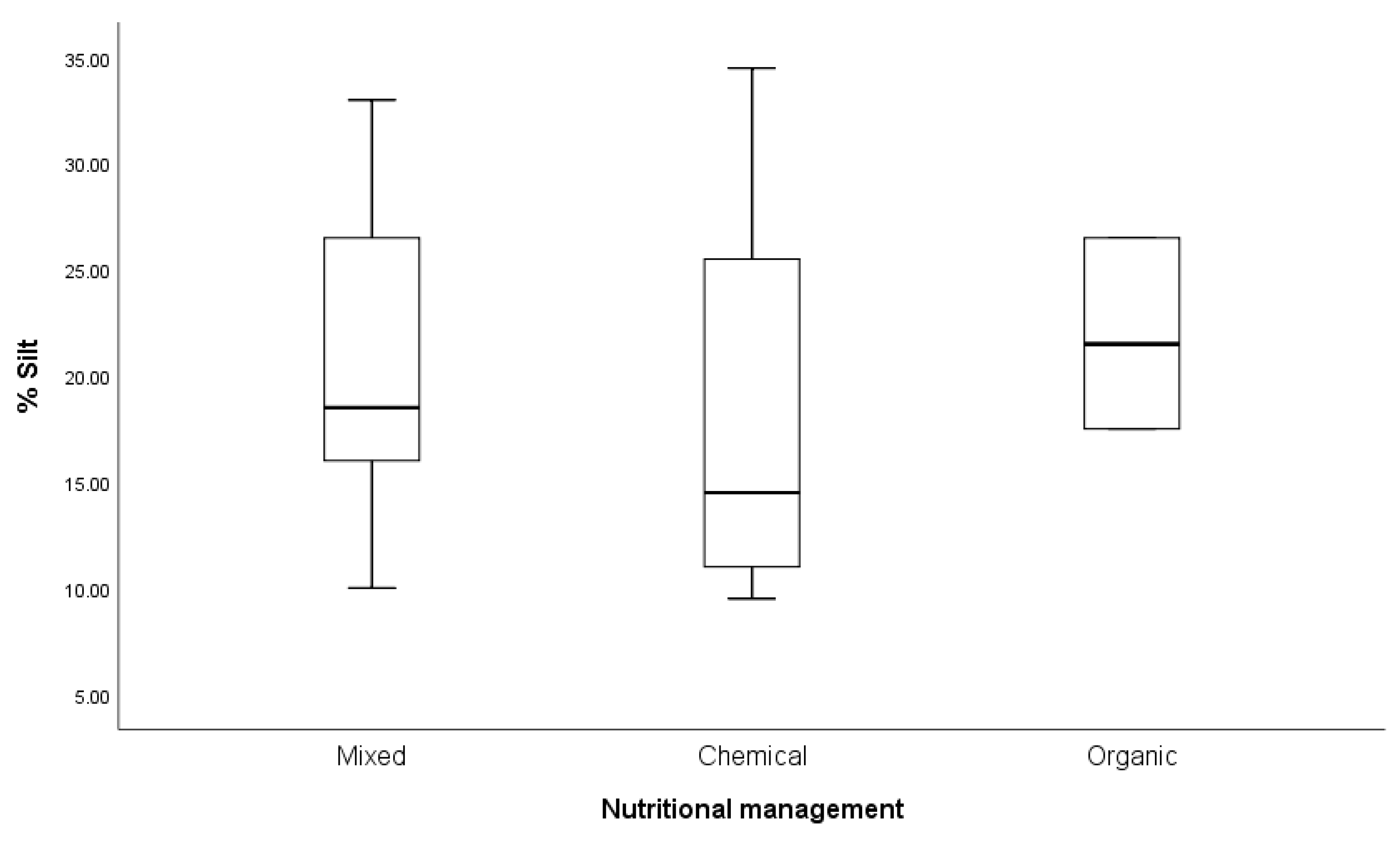
| Soil Parameters | Units | Nutritional Management | ||
|---|---|---|---|---|
| Organic | Chemical | Mixed | ||
| NO3 | mg kg−1 soil | 68.77 (20.52) a | 70.65 (36.81) a | 105.02 (63.46) b |
| NH4 | mg kg−1 soil | 0.59 (0.30) a | 0.43 (0.11) a | 0.46 (0.18) a |
| OM | % | 4.23 (1.07) a | 3.00 (1.33) b | 4.41 (0.89) a |
| H | % | 17.99 (1.08) a | 15.32 (3.65) b | 17.94 (2.17) a |
| pH | 5.01 (0.16) a | 5.16 (0.19) b | 4.92 (0.27) a | |
| Bulk density | g cm−3 | 0.89 (0.080) a | 0.95 (0.16) a | 0.92 (0.079) a |
| Sand | % | 72.96 (6.67) a | 70.88 (9.13) a | 71.70 (6.24) a |
| Clay | % | 5.21 (4.78) a | 10.87 (9.93) a | 7.24 (3.36) a |
| Silt | % | 21.83 (3.79) a | 18.25 (9.91) b | 21.05 (7.03) a |
© 2019 by the authors. Licensee MDPI, Basel, Switzerland. This article is an open access article distributed under the terms and conditions of the Creative Commons Attribution (CC BY) license (http://creativecommons.org/licenses/by/4.0/).
Share and Cite
Casanova Olaya, J.F.; Rodríguez Salcedo, J.; Ordoñez, M.-C. Impact of Nutritional Management on Available Mineral Nitrogen and Soil Quality Properties in Coffee Agroecosystems. Agriculture 2019, 9, 260. https://doi.org/10.3390/agriculture9120260
Casanova Olaya JF, Rodríguez Salcedo J, Ordoñez M-C. Impact of Nutritional Management on Available Mineral Nitrogen and Soil Quality Properties in Coffee Agroecosystems. Agriculture. 2019; 9(12):260. https://doi.org/10.3390/agriculture9120260
Chicago/Turabian StyleCasanova Olaya, Juan Fernando, Judith Rodríguez Salcedo, and María-Cristina Ordoñez. 2019. "Impact of Nutritional Management on Available Mineral Nitrogen and Soil Quality Properties in Coffee Agroecosystems" Agriculture 9, no. 12: 260. https://doi.org/10.3390/agriculture9120260
APA StyleCasanova Olaya, J. F., Rodríguez Salcedo, J., & Ordoñez, M.-C. (2019). Impact of Nutritional Management on Available Mineral Nitrogen and Soil Quality Properties in Coffee Agroecosystems. Agriculture, 9(12), 260. https://doi.org/10.3390/agriculture9120260






